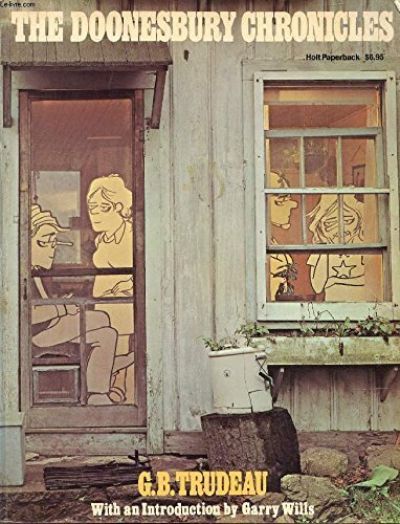Years Go By
The Doonesbury Chronicles
By G. B. Trudeau

28 Nov, 2021
G. B. Trudeau’s 1975 The Doonesbury Chronicles collects 501 daily Doonesbury strips first published between Oct. 26, 1970, and Dec. 20, 1974, as well as seventy-nine Sunday strips from Dec. 27, 1970, to Dec. 22, 1974.
October 26, 1970: crudely drawn football quarterback “B.D.” meets equally poorly drawn roommate Mike Doonesbury for the first time.

It is an unpromising beginning of more than a half-century of daily and Sunday weekly cartoons ranging from slice of life to political commentary.
Chroniclesbegins with a lengthy introduction by Gary Wills. Wills places Doonesburyin its greater cultural context, which Wills uses to criticize other strips he felt had betrayed earlier promise.
It’s hard to summarize a slice of life cartoon. Having established the core cast, Trudeau adds other archetypical students such as pothead perpetual undergrad hippy Zonker, revolutionary Mark, cheerleader Boopsie, feminist Nicole, as well as various parental figures. Characters from outside academia begin to appear, such as Joanie Caucus, who abandons unfulfilling life as a housewife for something better, the Rev. Scot Sloan, a fighting priest who can talk to young people (or so he believes), thinly disguised Hunter S. Thompson stand-in Uncle Duke, and gullible reporter Roland Burton Hedley, III. The cast then incorporates non-US characters such as Phred (a Vietnamese solder/terrorist B.D. befriends after signing up with the US military to get out of a term paper). Not all of the characters are fictional: habitual television show pre-emptor Richard Nixon and his associates appear in the form of word balloons over the White House.
While there are storylines, they tend to be short and fairly well contained. Many are inspired by real life: the founding of Walden Commune (where the central cast lives), B.D.’s service in Vietnam, Mark’s squabbles with his father, Mark and Mike’s quest to discover America1 (which ends more happily than it does in Easy Rider), Joanie’s escape from her confining marriage, Phred’s disastrous holiday, and of course the ongoing adventures of the whole Watergate crew. Readers may be able to spot Trudeau’s sources of inspiration, which he often elaborates with deliberate absurdity.
~oOo~
The art in this is awful. But … it’s heartening to know that an inability to draw is not necessarily an impediment to a long and successful career in cartoons. The kerning is also not great, although that’s really only an issue with a minor recurring character, Clint.
Early on, Doonesbury is an unthreatening slice of life comic, populated by broadly drawn characters of the sort one might have encountered at US universities back when tuition was $4500 per year. B.D. is a gridiron-glory-obsessed QB, Mike is a well-meaning liberal loser as unsuccessful at courting women2 as he is bridging the gap between the races3, B.D.’s Boopsie is an astonishingly dim cheerleader, Mark is a would-be revolutionary who is a perpetual disappointment to his father, and so on. All pretty safe stuff. This is ground Doonesbury could have continued to plow for years to come. But it didn’t.
For that, readers may thank Richard M. Nixon (as odd as it seems to thank Nixon for anything). Incorporating Watergate into the strip’s continuity helped Doonesbury grow out of the gag-a-day rut. Strips like the one below certainly helped move the cartoon from the comics page to the opinion section.

The strip that first caught my interest was an early Sunday colour strip in which one of B.D.’s fellow soldiers suggests that maybe instead of palling around with enemy soldier Phred4, B.D. should just shoot him, a suggestion the QB rejects. I’d link to it if I could find it online.
Having followed the strip for half a century, it’s interesting to see the seeds Trudeau plants, in light of what those seeds grew into. None of the characters remained static. Even seemingly minor characters like Lacey Davenport (featured living in sin with her boytoy of more than thirty years, Richard) could experience lengthy storylines of their own. As well, some of them developed in unexpected ways; B.D. turns out to be a surprisingly sympathetic character for someone who began as a one-note jock.
Despite the collection’s flaws (the art and the kerning), reading this was an enjoyable walk down memory lane. I’ll probably reread the rest of my collection.…
The Doonesbury Chronicles is available here (Amazon US), here (Amazon Canada), and here (Amazon UK).
The Doonesbury Chronicles does not appear to be available from Barnes & Noble, Book Depository or Chapters-Indigo.
1: A minor mystery: Mark supplies the motorcycle and Mike provides a side-car. Why would someone without a motorcycle own a side-car?
2: It may not help that either Mike forgot the name of his high school sweetheart or that he had at least two.
3: On the one hand, not a lot of American comic strips acknowledged the existence of African-Americans. On the other, Doonesbury’s portrayal of them, while better than Dennis the Menace’s, often fails to exceed expectations. Although I suppose one could argue Clyde is no more shiftless than Zonker.
Perhaps I could write an essay on the useless men of Doonesbury: B.D.’s father, Zonker, Zipper, Clyde, Jeremy and of the man against whom all the other slackers look like overachieving stalwarts, that fucker Zeke. In fact, I can’t think of a woman in the strip who works as hard at not working as that group of men. Joanie’s daughter/Mike’s ex-wife J.J. is extremely flawed, but at least she works hard.
4: One does not get the impression that Trudeau’s research into southeast Asia was especially detailed. But how many American cartoonists in the early 1970s acknowledged that Asia existed or featured an enemy soldier from SEA as a sympathetic character?
